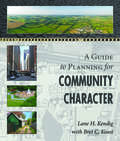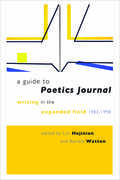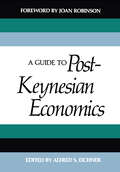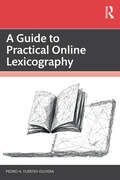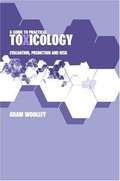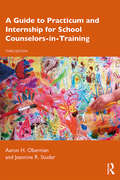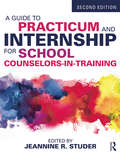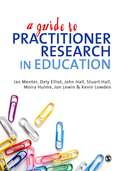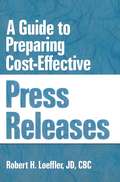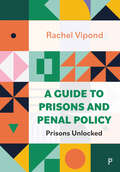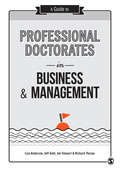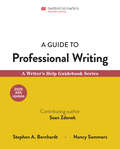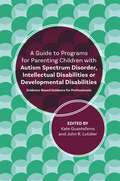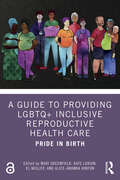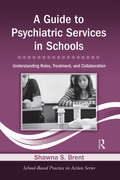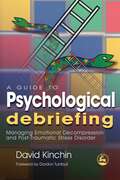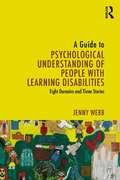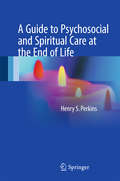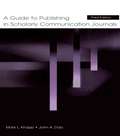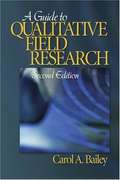- Table View
- List View
A Guide to Planning and Support for Individuals Who Are Deafblind
by John McinnesIn this ground-breaking collection, leading experts in the field address the problems of parents, intervenors, and professionals who work with people who have been deafblind since birth or from a very early age. Individuals who are congenitally deafblind face the same challenges as those who become deafblind later in life, but they have not had the same opportunity to develop the communications skills and a conceptual base needed to construct an understanding of the world. The contributors address identification of deafblindness, planning and intervention, development, family support, and education.Just as McInnes and Treffry's "Deafblind Infants and Children" helped to change the approach to and the perception of deafblind children, this collection will assist in fostering a new approach to the education of and support for older children, youth and adults who are deafblind. An essential part of this process is to set forth standards for program development, implementation, and evaluation, which this volume aims to accomplish. It will make an essential contribution to the expanding field of services for the deafblind population of all ages, and to the improved understanding of parents, family members, and professionals who support them.
A Guide to Planning for Community Character
by Lane H. KendigA Guide to Planning for Community Character adds a wealth of practical applications to the framework that Lane Kendig describes in his previous book, Community Character. The purpose of the earlier book is to give citizens and planners a systematic way of thinking about the attributes of their communities and a common language to use for planning and zoning in a consistent and reliable way. This follow-up volume addresses actual design in the three general classes of communities in Kendig's framework-urban, suburban, and rural. The author's practical approaches enable designers to create communities "with the character that citizens actually want." Kendig also provides a guide for incorporating community character into a comprehensive plan. In addition, this book shows how to use community character in planning and zoning as a way of making communities more sustainable. All examples in the volume are designed to meet real-world challenges. They show how to design a community so that the desired character is actually achieved in the built result. The book also provides useful tools for analyzing or measuring relevant design features. Together, the books provide a comprehensive treatment of community character, offering both a tested theory of planning based on visual and physical character and practical ways to plan and measure communities. The strength of this comprehensive approach is that it is ultimately less rigid and more adaptable than many recent "flexible" zoning codes.
A Guide to Poetics Journal: Writing in the Expanded Field, 1982–1998
by Lyn Hejinian Barrett WattenLyn Hejinian and Barrett Watten are internationally recognized poet/critics. Together they edited the highly influential Poetics Journal, whose ten issues, published between 1982 and 1998, contributed to the surge of interest in the practice of poetics. A Guide to Poetics Journal presents the major conversations and debates from the journal, and invites readers to expand on the critical and creative engagements they represent. In making their selections for the guide, the editors have sought to showcase a range of innovative poetics and to indicate the diversity of fields and activities with which they might be engaged. The introduction and headnotes by the editors provide historical and thematic context for the articles. The Guide is intended to be of sustained creative and classroom use, while the companion Archive of all ten issues of Poetics Journal allows users to remix, remaster, and extend its practices and debates.
A Guide to Post-Keynesian Economics
by Alfred S. EichnerDoes there exist an alternative to the “neoclassical synthesis” presented to students in introductory, intermediate, and advanced economics courses? The alternative is the post-Keynesian theory which is the subject of this book.
A Guide to Practical Online Lexicography
by Pedro A. Fuertes-OliveraA Guide to Practical Online Lexicography provides a step-by-step course on digital lexicography, discussing state-of-the-art theoretical lexicography and offering a guide to practical lexicography, with a focus on monolingual online dictionaries.Dictionaries today need to be designed and made for online environments, use up-to-date technologies in all aspects of lexicography, and have adequate business models in place for financing them. This book:• Covers lexicographic data and categories of existing online dictionaries, and shows how to plan, analyse, and store data.• Discusses the relationship between technology, dictionary users and dictionary makers, lexicographic developments, and economic costs.• Provides an in-depth case study of designing and making the Diccionario Digital del Español (DIDES), an online dictionary of Spanish edited by the author.• Includes further reading recommendations, practical activities, and questions for discussion at the end of each chapter.Drawing on materials developed by the author from his experience of over 20 years of lecturing in universities and institutions globally, this is a practical go-to guide to online lexicography for students of lexicography, e-lexicographers and researchers.
A Guide to Practical Toxicology: Evaluation, Prediction and Risk
by Adam WoolleyAn experienced toxicologist researcher and consultant provides an overview of toxicology for practicing toxicologists and students in the field, with 15 chapters addressing topics from the necessity of measurement and definitions and maintenance of normality to larger issues of risk assessment and management in the workplace and environment and the future of toxicity testing. Pedagogical tools include text boxes with necessary background information; tables and case studies; and study design and interpretation. Annotation ©2004 Book News, Inc., Portland, OR (booknews.com)
A Guide to Practicum and Internship for School Counselors-in-Training
by Jeannine R. Studer Aaron H. ObermanThe ideal resource for school counseling field experiences, the updated and expanded third edition of A Guide to Practicum and Internship for School Counselors-in-Training covers all aspects of the practicum and internship experience from the initial contact with supervisors to detailed descriptions of students’ different roles. Readers will gain an awareness of school culture and the understanding needed to develop an individualized philosophy of school counseling. Each chapter contains activities, case studies, worksheets, and images to facilitate understanding, and all material is consistent with both the Council for Accreditation of Counseling and Related Educational Programs (CACREP) 2016 Common Core and School Counselor Entry-Level Specialty Areas and the school counselor standards identified by the American School Counselor Association (ASCA). Specific focus is given to strategies for implementing the ASCA National Model (4th edition) as a part of clinical experiences. This text can be used by faculty, students, and supervisors alike to support and enhance the school counseling knowledge base used to meet the needs of all students.
A Guide to Practicum and Internship for School Counselors-in-Training
by Jeannine R. StuderA Guide to Practicum and Internship for School Counselors-in-Training, 2nd ed, covers all aspects of the practicum and internship experience, from the initial contact with supervisors to detailed descriptions of students’ different roles. Readers will gain both an awareness of the school culture and the understanding needed to develop an individualized philosophy of school counseling. Specific topics covered include popular counseling theories used by school counselors, strategies for working with special populations of students, understanding the school counselor's role in utilizing the 2012 National Model of the American School Counselor Association (ASCA) including the inherent elements and themes, putting the ASCA ethical standards into practice, and administration of day-to-day tasks. Each chapter contains activities, case studies, worksheets, and images to facilitate understanding, and all material presented is consistent with both the accreditation standards of the Council for the Accreditation of Counseling and Related Educational Programs (CACREP) and the school counselor standards identified by the ASCA.
A Guide to Practitioner Research in Education
by Ian Menter Dely Elliot Moira Hulme Jon Lewin Kevin LowdenDrawing on short texts that were produced by the former Scottish Council for Research in Education (SCRE), Menter et al. (education, U. of Glasgow, UK), some whom have worked in the SCRE, introduce education students and experienced teachers to practitioner research. They explain what it is and what it means for teachers, lecturers, and other education professionals; why to engage in it, such as for initial teacher education, school improvement, or policy development; and its elements: the research question, values and ethics, secondary data, the literature review, questionnaires, interviewing, focus groups, observation, and other methods like using photos, diaries, and drawings. They end with explanation of quantitative and qualitative data analysis and sharing research. Annotation ©2012 Book News, Inc. , Portland, OR (booknews. com)
A Guide to Prayer for Ministers and Other Servants
by Rueben P. Job Norman ShawchuckThis book was prepared out of our own desperation and search: desperation to find forgiveness for sin, release from guilt, the living God as a companion in our lives and ministries; and a search for resources and disciplines to help keep our relationship with God alive and vital every day. This book, therefore, is not a treatise written by experts; rather, it is a collection of resources by two pilgrims. Every scripture, prayer, and writing in this book has been used for our own journey. We each have pondered the scriptures and writings and prayed the prayers; we have given ourselves to the daily discipline and the monthly private retreats.
A Guide to Preparing Cost-Effective Press Releases
by William Winston Robert H LoefflerA Guide to Preparing Cost-Effective Press Releases is an instructional approach to writing and effectively using the press release. It offers suggestions and recommendations for creating basic press releases and details how the release can extend the life of an ad campaign, providing high degree publicity at low cost.In an age of great emphasis on high performance, cost effectiveness, measurable success, and fast results, this book explains how a well-developed press release program can “super charge” an advertising program. Robert Loeffler reviews the basics of press release writing, gives several examples of successful press releases, and explains in detail how the reader can set up an ongoing press release program to provide a high degree of effective publicity at very low cost. As a major form of communication for businesses, public and private institutions, and the government, the press release is a tailor-made promotional tool for both large and small budgets. Loeffler discusses the mechanics of writing press releases, providing the press release writer with:a diagrammed writing approach for clear structurea list of do's and don'ts to prevent common errorssamples of the most common types of releasesa step-by-step explanation of release production, so as not to overlook important tasks for completionsuggestions on how to write related releases, such as tradeshow press kitsExperienced in-house communications and PR writers, nonprofit PR staffs, government and military public affairs staffs, and advertising agency writers will find Loeffler's book a handy reference for polishing press release writing skills. College undergraduate classes in journalism, technical writing, and business communication will find A Guide to Preparing Cost-Effective Press Releases a useful tool in learning the fundamentals of press release writing.
A Guide to Prisons and Penal Policy: Prisons Unlocked
by Rachel VipondUnderstanding prisons and the policies surrounding them is of fundamental importance to students and practitioners of criminology and related fields. This concise and accessible guide offers a compendium of key information, theories, concepts, research and policy, presenting a rounded and critical overview of the prison system in England and Wales. Covering the historical and contemporary context of prisons, the text guides the reader through the work of prison officers, a tour of international prisons and how prison life is experienced by different groups, such as women. Focusing on the experiences of stakeholder groups and the themes of power, legitimacy and rehabilitation, the book concludes with an overview of the future challenges for prisons. Each chapter includes key learning features: • end of chapter questions; • definitions of key terms and concepts; • examples and illustrative case studies; • learning outcomes; • summary boxes of major research studies and further reading.
A Guide to Professional Doctorates in Business and Management
by Jim Stewart Lisa Anderson Professor Richard Thorpe Jeff Gold*Shortlisted in the Management and Leadership Textbook Category at CMI Management Book of the Year Awards 2017* Lecturers, request your electronic inspection copy here. Are you undertaking (or thinking of doing) a Doctor of Business Administration (DBA) or other professional doctorate (PD) in business and management? Or perhaps you’re supervising and delivering one of these programmes? This is your complete - and practical - guide to succeeding on this course. A Guide to Professional Doctorates in Business and Management has been written by a team of experts with experience of the challenges faced in both studying for and supervising professional doctorates in business and management. Inside they address the key issues faced, in particular how these courses differ from a traditional PhD, and the different skills and approach needed for success. Chapters explore the nature and importance of PDs as leading change in the professional world of practice, and how they need to differ from traditional forms of doctorate such as PhDs. The guide also offers practical guidance on researching in this particular mode, and through writing and publishing a thesis, making a valuable contribution to professional knowledge.
A Guide to Professional Doctorates in Business and Management
by Jim Stewart Lisa Anderson Professor Richard Thorpe Jeff GoldAre you undertaking (or thinking of doing) a Doctor of Business Administration (DBA) or other professional doctorate (PD) in business and management? Or perhaps you're supervising and delivering one of these programmes? This is your complete - and practical - guide to succeeding on this course. A Guide to Professional Doctorates in Business and Management has been written by a team of experts with experience of the challenges faced in both studying for and supervising professional doctorates in business and management. Inside they address the key issues faced, in particular how these courses differ from a traditional PhD, and the different skills and approach needed for success. Chapters explore the nature and importance of PDs as leading change in the professional world of practice, and how they need to differ from traditional forms of doctorate such as PhDs. The guide also offers practical guidance on researching in this particular mode, and through writing and publishing a thesis, making a valuable contribution to professional knowledge.
A Guide to Professional Writing: A Writer's Help Guidebook Series
by Nancy Sommers Stephen A. Bernhardt Sean ZdenekWith 2020 APA Update A Guide to Professional Writing, part of the Writer’s Help Guidebook Series, offers writing and research support for students writing in the discipline. This compact yet comprehensive guidebook provides the value students want with the essential instruction they need to get their writing tasks completed successfully. Students will find advice on how to think, read, research, design and write papers, projects and presentations like a professional writer. Coverage includes the following topics, all focused on the specific needs of professional writers: * Writing process * Conventions in the discipline * Integrating and evaluating sources * Documentation style required in the discipline--with plenty of models * Sample student writing
A Guide to Programming in Java: Java 2 Platform Standard Edition 5
by Beth BrownThe book is intended to provide introduction to programming using Java and to prepare students for further study in the programming/computer science field.
A Guide to Programs for Parenting Children with Autism Spectrum Disorder, Intellectual Disabilities or Developmental Disabilities: Evidence-Based Guidance for Professionals
by V. Mark Durand Susan Timmer Anthony Urquiza Katelyn M. Guastaferro John R. Lutzker Yona Lunsky Lynn Koegel Brittany Koegel Robert Koegel Shelley Clarke Julia Strauss Laura Lee McIntyre Mallory Brown Melissa A. Mello Meagan Talbott Sally Rogers Sandy Magana Wendy Machalicek Kristina Lopez Emily Iland Brandi Hawk Ronit M. Molko-Harpaz Kenneth Fung Lee Steel Kelly BryceThis book provides a comprehensive outline of the major parent training programs for parents of children with intellectual or developmental disabilities (IDD), including Autism Spectrum Disorder. Parents or primary caregivers spend the most time with a child, and training them in behaviour management and intervention strategies is critical to improving a child's behaviour, to helping them to learn new skills, and to reduce parental stress. Authored by eminent specialists in the field and written for researchers and clinicians supporting or treating families, each chapter focuses on one of the key evidence-based parent training programs - from Incredible Years® and Positive Family Intervention through to Pivotal Response Treatment and Acceptance and Commitment Therapy. Each chapter provides a breakdown that features an introduction to the model, evidence for the model, a full description of the model, a discussion of implementation and dissemination efforts, and concluding comments. Grounded in research, this definitive overview provides the evidence and guidance required for anyone considering investing in or running a parenting program.
A Guide to Providing LGBTQ+ Inclusive Reproductive Health Care: Pride in Birth
by Mari Greenfield Kate Luxion El Molloy Alice-Amanda HintonThis evidence-based guide brings together a wide range of information and practical tools for midwives, obstetricians, nurses, health visitors and birthworkers, empowering them to provide safe and compassionate care throughout the reproductive journeys of lesbian, gay, bisexual, transgender and queer (LGBTQ+) people. This book may also be helpful to LGBTQ+ people in their own reproductive journeys.Throughout history, in cultures around the world, LGBTQ+ people have become pregnant, sought abortion care, miscarried, experienced infertility, given birth, and made decisions about infant feeding. Their reproductive journeys are increasingly visible, reflecting the changing social and legal recognition of sexual and gender minority people as parents. LGBTQ+ people require support during these significant life events which is appropriate, expert, and meets their needs. However, healthcare professionals and birthworkers may not always be confident in working with these clients and may lack understanding of LGBTQ+ clients’ experiences. There is also often insufficient attention paid to differences in the LGBTQ+ non-gestational parents' experiences. Taking an interdisciplinary approach, this book brings together up-to-date research findings from a range of fields including medicine, psychology, sociology, law and public health, to provide a knowledge base and tools to support clients at different stages of pregnancy and parenthood. The book follows the reproductive journey, moving from pre-conception and fertility research, through pregnancy and birth, to postnatal physical and mental healthcare. It also addresses termination care and perinatal loss.The chapters contain vignettes to personalise the issues discussed, highlights key practice recommendations, and suggestions for further reading. This is an essential guide for student midwives and medical students, as well as health visitors, midwives and obstetricians in practice.The Open Access version of this book, available at http://www.taylorfrancis.com, has been made available under a Creative Commons [Attribution-Non Commercial-No Derivatives (CC BY-NC-ND)] 4.0 license.
A Guide to Psychiatric Services in Schools: Understanding Roles, Treatment, and Collaboration (School-Based Practice in Action)
by Shawna S. BrentIn order to provide comprehensive care to students with a wide variety of social and emotional challenges, close collaboration between psychiatrists and school-based mental health professionals is vital. This book provides practical information about psychiatric diagnoses and medications, as well as effective ways to communicate with physicians, to ensure that the needs of all students and their families are met. Brent reviews the process and content of a psychiatric evaluation, the general principles of psychopharmacology, and the various classes of medications. Subsequent chapters then focus on different psychiatric diagnoses and treatment options. Characteristics, evaluation, and treatment methods are discussed for mood, anxiety, psychotic, pervasive developmental, and externalizing behavior disorders with case examples provided throughout for illustration. A brief overview of mental health crises, including suicidal statements, physical aggression, and self-harm behaviors, and how these can best be handled in the educational setting is also provided. School-based mental health professionals will find this book to be a clear, concise, and practical guide to facilitating strong communication and collaboration amongst themselves, educators, and physicians.
A Guide to Psychological Debriefing: Managing Emotional Decompression and Post-Traumatic Stress Disorder
by David Kinchin'In its essence, this is a practical book that focuses on aiding recovery from trauma over a carefully structured timeframe. Amongst other things, it provides an introduction to the concept of psychological debriefing and some of the effects of trauma, including post-traumatic stress disorder (PTSD). This book will appeal to a broad audience because it is easily accessible, not only to those professionals working with clients suffering from PTSD, but also to health practitioners, psychologists, social workers and counsellors, as well as students.' - Well-Being 'David Kinchin pays special attention to setting up optimal conditions to facilitate emotional decompression. He takes into account that trauma reactions, primarily concerned with survival, are whole-system reactions, affecting both the body and mind. He also reminds us that the initial impact of the trauma is on physical structures in the brain, disrupting memory-processing capacity, which is designed to create space and time to heal. We should all pay a great deal of attention to what he says.' - Professor Gordon Turnbull, Consultant Psychiatrist, University of Chester, Capio Nightingale Hospital, London and Ridgeway Hospital, Swindon, UK Traumatic events strike unexpectedly and turn everyday experiences upside down. Frequently, people suffering such trauma cannot shake the experience and develop Post-Traumatic Stress Disorder (PTSD). Psychological debriefing (PD) is a widely practised process used as an intervention for treating people who have been exposed to trauma. It allows people who have been exposed to trauma to re-examine the traumatic event in a safe and controlled environment, and reduces the risks of developing PTSD. This book is a practical introduction to PTSD and psychological debriefing, and offers an enhanced model of PD which the author terms `Emotional Decompression'. Structured like a deep-sea dive, which has to include carefully planned safety stops on the way back to the surface to avoid getting `the bends', this model provides time frames for how long to spend at various stages of the PD process, and when to stop for discussions and explanations. The focus is on aiding recovery from this `invisible injury' over carefully structured time. The book presents a range of recovery models, from the `simple' models developed by Williams and Horowitz to the more complex `Snakes and Ladders' model developed by the author. Appendices include an essay by one of the world's leading exponents of psychological debriefing, Atle Dyregrov, as well as case studies of debriefs completed by the author, including that of a survivor of the July 7th bombings in London. A Guide to Psychological Debriefing is an essential book for health practitioners, counsellors, psychologists and professionals working with clients suffering from PTSD, as well as students.
A Guide to Psychological Understanding of People with Learning Disabilities: Eight Domains and Three Stories
by Jenny WebbWho are the people we describe as having learning or intellectual disability? Many clinical psychologists working in a mental health setting are now encountering people with learning disabilities, in some cases for the first time. This book provides the background information and understanding required to provide a basis for a truly inclusive and effective service for people with learning disability. In A Guide to Psychological Understanding of People with Learning Disabilities, Jenny Webb argues that we need a new, clinically-based definition of learning disability and an approach which integrates scientific rigour with humanistic concern for this group of people, who are so often vulnerable to misunderstanding and marginalisation. Psychological approaches need to be grounded in an understanding of historical, theoretical and ethical influences as well as a body of knowledge from other disciplines. The Eight Domains is a simple but holistic method for information gathering, while The Three Stories is an integrative model of formulation for use in relation for those people whose needs do not fit neatly into any one theory. Divided into three sections, the book explores: Understanding the context Understanding the person: eight domains Making sense: three stories. This book provides an invaluable guide for trainee clinical psychologists and their supervisors and tutors, working with adults with learning disability. It will also be valuable for clinical psychologists working in mainstream settings who may now be receiving referrals for people with learning disability and want to update their skills.
A Guide to Psychosocial and Spiritual Care at the End of Life
by Henry S. PerkinsPsychological, social, and spiritual care is as important as physical care at the end of life. Yet caregivers often feel ill-equipped to give that nonphysical care. This book shows how to do it. The book addresses all caregivers who attend dying patients: doctors, nurses, chaplains, clergy in the pastorate, social workers, clinical psychologists, family caregivers, and others. It covers such topics as the functional and emotional trajectories of dying; the varied approaches of patients and caregivers to end-of-life decisions; culturally based beliefs about dying; the differences between depression and grief; and people's views about the right time to die, the death experience itself, and the afterlife. For each topic the book introduces core concepts and summarizes recent research about them. The book presents much of its material in readable tables for easy reference; applies the material to real-life cases; lists the main "take home" points for each chapter; and gives references for additional reading. The book helps caregivers anticipate the reactions of patients and survivors to end-of-life traumas and suggests how caregivers can respond insightfully and compassionately. At the same time the book challenges caregivers to think through their own views about death and dying. This book, therefore, is a must-read for all caregivers―professional and nonprofessional alike―who strive to give their patients comprehensive, high-quality end-of-life care.
A Guide to Publishing for Academics: Inside the Publish or Perish Phenomenon
by Jay LiebowitzMost academics still wrestle with the "publish or perish" phenomenon. Based on Dr. Liebowitz's 25 years serving as the editor-in-chief of a leading international journal, along with insights from some of the most knowledgeable journal editors, this book shares key lessons learned to help new professors, doctoral students, and practitioner-scholars
A Guide to Publishing in Scholarly Communication Journals (Published for the International Communication Association)
by John A. Daly Mark L. KnappThis guide offers detailed advice on the journal article publication process, describing each step of the process and providing insights for improving the presentation of work intended for publication in communication journals. It includes advice from journal editors across the discipline and offers resource materials to help both new and seasoned writers publish their work. The guide begins with an overview of the publication process, followed by a discussion of each step of the manuscript submission, review, and revision processes. In addition to reality-based answers to questions often posed to editors, resource materials are provided in the appendices, introducing readers to the various forms and correspondence they will encounter when they submit their work for consideration. The guide focuses on the issues and procedures associated with the publication process, examining rules and expectations encountered during the publishing process that are often assumed to be known but are rarely articulated. The guidance provided here will aid in establishing consistency in publication practices and will contribute toward improving the quality of journal submissions, as well as enhancing interaction with editors and reviewers. As a guide to demystifying procedures associated with the publication process, this resource will serve all academic authors desiring to publish their work in scholarly communication journals.
A Guide to Qualitative Field Research
by Carol A. BaileyThoroughly revised, the Second Edition of A Guide to Qualitative Field Research provides novice researchers with comprehensive and accessible instructions for conducting qualitative field research. Using rich examples from classic ethnographies to help bring abstract principles alive, author Carol A. Bailey thoroughly explains the entire research process from selecting a topic to writing the final manuscript, and all of the steps in between!

